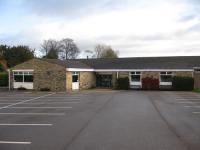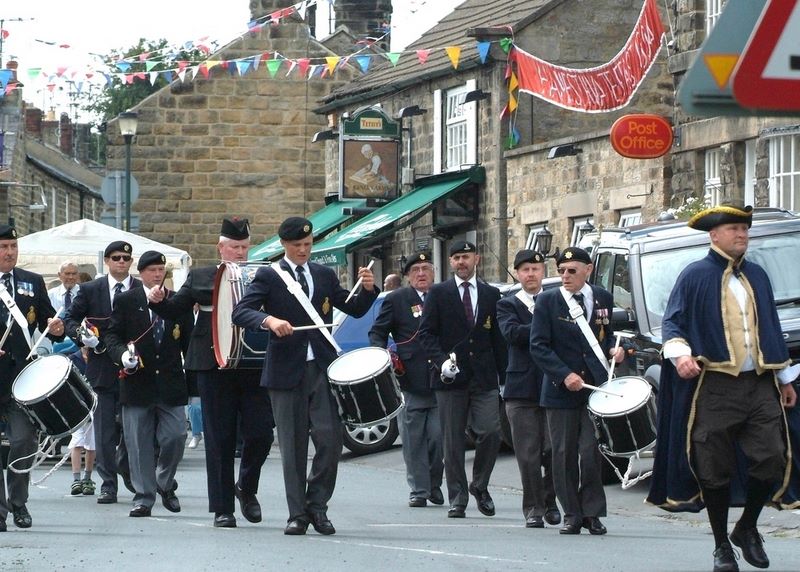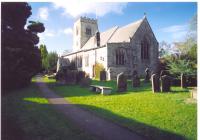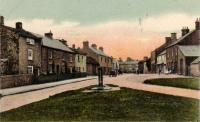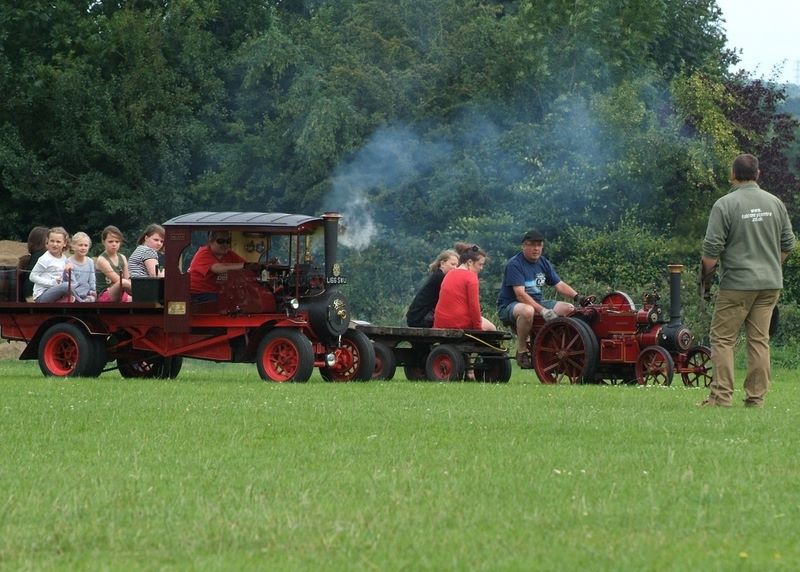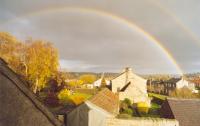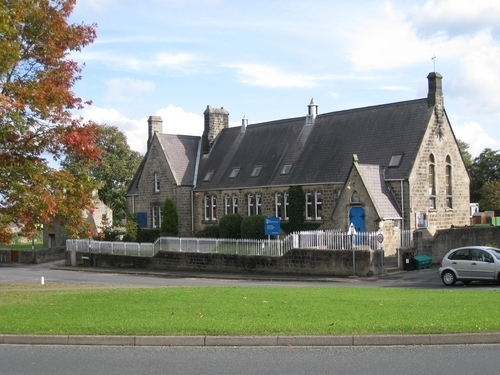Recent articles
© DT Online 2010 - 2025
| Recollections of HampsthwaiteMy name is Maurice Wray and I was born in Chapel Allerton, Leeds in 1934. The photo is taken around 1939 and they are sitting on the 'Bink' or stone seat which was then outside the front of his house (now Lamb Cottage, on Church Street, Hampsthwaite). All materials provided by Ian Wray - October 2013 (Click on photos to enlarge) I can remember going to visit William my great grandfather when I would have been four or five years old, in around 1939. Sarah Anne had died in February 1924 and William lived alone by this stage.
His house was a two up two down cottage, but unlike the present day Lamb Cottage, it did not have mullioned windows and the internal boundaries of the house were different to how they appear today. Looking from the front, the window right of the front door, immediately left of what is now Cornerstone House did not belong to my great grandfather’s house. This must have been part of that house to the right. (Although my mother told me this used to be the Temperance Hotel, I think it was just a house when I visited in the late 1930’s).  Diagram made by Maurice Edward Wray in 2013, depicting the layout of his great grandfather's house as he remembered it up to 1940. (now Lamb Cottage)
So on entering the house by the front door, which was roughly five feet to the right of its position today, you would find your self in the living room. Immediately in front of you was another door behind which was the stairs to the two bedrooms. In the living room there was an open fire in a cast iron, black leaded range. Amongst the furniture was a William Snow grandfather clock. These clocks were made nearby in Padside in the late 1700's and early 1800's. I had heard it said that the works were made in Padside but that the wooden cases were made in Hampsthwaite and that was how the Joiners Arms pub got its name. This clock was apparently very temperamental and could not be moved. Consequently when ever the room was decorated, the wall paper always stopped at the edge of the clock case.
 William Busfield (1859-1940). The photograph was taken by his grandson Dick Wheatley. An annotation on the reverse, says 'Portrait of a Gentleman. Whit Tuesday 1935'. William would have been 76 years old.
Through a door in the (North) end wall of the living room was the kitchen with a large shallow white porcelain sink. There were no taps but a waste pipe ran through the wall to the front of the house. Above the sink was a window looking out into Church Lane. Immediately outside this window was the same stone seat which still stands outside the house, albeit now in a different position alongside Cornerstone House.
My mother always referred to this seat as ‘the bink’. (This term appears in an online north eastern dialect dictionary defined as a seat of wood stone or sods often placed against a wall).  William Busfield 1859-1940. Photo taken in about 1939, in the back garden of his house, which is now Lamb Cottage.
To the left (North) of the house, was an outbuilding (now The End Cottage) with a door which lead through to the back garden. This again was not part of William’s house. The keys were kept by a woman who lived nearby, presumably the person who William rented the house from.
The page on the Hampsthwaite website about the Lamb Inn mentions William Busfield my great grandfather in this house (Also referred to in the Hampsthwaite Book 1, in the chapter by George Wainwright) and says that the house did not have services of any kind. By the time I visited, there was certainly mains gas in the house, because the living room was lit by a gas mantle and there was a gas stove in the kitchen (in addition to the original range around the living room fire). The stone fagged floor was covered in coconut matting and home made clipped rugs. Drinking water was obtained from a pump in the back garden, which was shared by the other houses backing onto the garden. The brick outbuilding which, still runs along the north side of the garden, was made up of coal houses which were filled through the wooden hatches in what is now the church car park. The only toilets were two dry closets in the end of this outbuilding furthest from the house. There was a water butt in the back garden which collected rainwater from the roof. This was used for washing clothes as it was softer than the water from the pump. My mother also told me that in times of drought it was necessary to carry buckets of water from the river for washing clothes.
I can remember that my great grandfather who was then in his late 70’s grew vegetables intensely in a well stocked garden at the back of his house and this was the whole area behind what are now 'Lamb' and 'End' cottages. I used to play with a trowel using mud to point the brickwork in the high wall along the bottom (East side) of the garden. On the opposite side of Church Lane next to (South of) the church was a piece of land with what appeared to be a small derelict building on it. I now realise that this was the old parish stable. Next to this were two semi detached houses (visible on the right of image 22 in Graham Smith’s collection of postcards). In the left hand semi lived the Ashbys. I used to play out with one of their boys called Brian. He was a couple of years older than me and when he was older still he used to come and stay in my street in Leeds with my Great Uncle Arthur (William Busfield’s younger son).
 Church Street, Hampsthwaite looking south from the position of the church gate. The vehicle is believed to be a horse drawn milk cart. Possibly taken in 1912
If you continued along Church Lane towards the village centre, there was a district nurse who lived in a flat above a garage where she kept a shiny 1935 model Austin 7 car. This was about where ‘Gooselea’ is now on Church Lane.
Further on again lived the Wrigglesworths who my mother knew very well. I believe she went to school with one of their daughters and told me how Mr Wrigglesworth, who was a roofer, used to take them all out for rides in his ‘Galloway’ car. Mr Wrigglesworth was another keen gardener and kept a large vegetable plot at the side of his house. In the house was a small room, which I can always remember. On the floor was heavy brown lino and it had shelves on all four walls from floor to ceiling. These shelves were filled with glass jars full of pickles and preserves. The jars all had red rubber seals and wire clasped lids. My mother, father and me continued to visit the Wrigglesworths well in to the 1940’s.  The watch which is accompanied by its original receipt, was owned by William Busfield (1859-1940) of Hampsthwaite.
When I was about four William my great grandfather gave me an H. Samuel pocket watch. More interestingly though he himself owned a Waltham pocket watch, which he bought for £3 and 5 shillings (£3.25) from A. H. Shires and Son jewellers at 13, Parliament Street in Harrogate on his 36th birthday; 10th April 1895. I know this because I still have the watch and the original receipt. A perpetual calendar tells us that his birthday fell on a Wednesday, which is notable because in those days it must have been quite unusual to have had a day off in the middle of the week.
When war was declared in September 1939 it was decided that my mother and I would be evacuated to live with my great grandfather in Hampsthwaite. I can still remember sitting on my mother’s knee, squeezed into the side-car of my father’s combination motorbike for the journey. However after two weeks my mother found village life too quiet and we returned to Leeds.
I visited again when William had taken a fall in 1940. I went with my mother on the train so that she could look after him and when we arrived at Hampsthwaite railway station it was pitch black, probably because of the wartime blackout. I can remember to this day the vivid orange glow from the firebox of the engine, at the time I thought it was fantastic. Unfortunately William never recovered from this fall and died about three months later. He is buried in Hampsthwaite church yard with his wife Sarah Anne, in an unmarked grave along side the marked grave of Sarah Anne’s friend Annie Hudson. After William’s death my father took the grandfather clock back to Leeds, and it ran in our house for a good many years without problems. When eventually it began to stop from time to time my dad, being a motor mechanic, stood the mechanism in the kitchen sink and using a garden rose sprayer doused it with ‘Redex’ carburettor cleaning fluid. He then rinsed it in paraffin, put it back together and it kept really good time but instead of striking nice and steadily as it should, it used to strike so quickly you could hardly count the hour. This required a further adjustment of the clutch brake mechanism, to slow the striking down. In the end though the wooden clock case infested our house with woodworm and it was thrown away, which is a shame because William Snow clocks can now be worth a couple of thousand pounds or more.
 Maurice Wray aged 14 sitting on the Boar Statue in Ripley, North Yorkshire. The photo was taken during a holiday which he spent camping with a friend at Sissy and John Foster's farm on Rowden Lane Hampsthwaite.
Even though my great grandfather had died, my mother and I regularly returned to Hampsthwaite to visit my Aunt Sissy Foster. She was not actually my aunty, but that’s how I referred to her and she lived with her brother John on a farm on Rowden Lane in the position where Rowden Grange is now. (My research has in fact revealed that Sissy (Elizabeth) and John (Christopher J.) were William Busfield's niece and nephew).
My mother and I used to catch a West Yorkshire bus to Harrogate and another one into Hampsthwaite. There was then what seemed for me as a young boy, a very long walk from the Joiners' Arms up Rowden Lane, which was then much narrower and had very high grass verges.
The farm had a cow shed, which would hold about eleven cows and as a 'townie' I found it fascinating to watch Sissy and John milking them. They also kept hens and we were happy to be given a few eggs to supplement our wartime rations. I still used to visit Sissy and John after the war and in 1948 aged 14, a friend and me camped in one of their fields for a week’s holiday. Gradually I suppose our links with Hampsthwaite all died away, but my mother enjoyed returning there now and again well into her 80’s. My mother died in 2002, but like her, I too continue to have a great affinity for the village. Additional Family photos William and Sarah Anne Busfield (ne Henson)  William Busfield 1859-1940. Resident of what is now Lamb Cottage, on Church Street, Hampsthwaite, North Yorkshire
 Sarah Anne Busfield (Ne Henson) 1857-1925, William Busfield 1859-1940 and their youngest son Arthur 1889-1972.
 On the left, Sarah Anne Busfield 1857-1925 Resident of what is now Lamb Cottage. On the right is her friend Annie Hudson. The two are burried side by side in the Hampsthwaite churchyard.
 Sheep dipping. Taken near Hampsthwaite around 1910. William Busfield of what is now Lamb Cottage, is the rightmost adult holding the long pole with a hooped end.
 Fred Busfield M.M. 1880-1924. Eldest son of Sarah Ann and William who were resident of what is now Lamb Cottage.
 Fred Busfield M.M. (1880-1924) eldest son of William and Sarah Anne of Hampsthwaite. Pictured around 1900 serving in Burma. Fred rejoined the army at the outbreak of WW1 and subsequently received the military medal. He survived the war but lost his leg
 Emily Busfield (1884-1928) (became Breaks through marriage). Mother of Dorothy Vivien Breaks and youngest daughter of William and Sarah Ann Busfield.
Dorothy Vivien Wray (ne Breaks)  Doroth Vivien Breaks (became Wray on marriage) 1908-2002. Aged about 5years. Spent much of her upbringing in Hampsthwaite and lived with her grandparents Sarah Ann and William Busfield. Residents of what is now Lamb Cottage
 Hampsthwaite village school photo of around 1921. Dorothy Vivien Breaks is the tall girl third from the right on the back row.
 Doroth Vivien Breaks 1908-2002 standing outside the door of her grandparents house which is now Lamb Cottage.
 Dorothy Vivien Wray (Ne Breaks) 1908-2002, with her only son Maurice Edward Wray (B-1934) sitting on the 'Bink' or stone seat which was then outside the front of her grandfather's house.
Maurice Wray Recollections of Hampsthwaite My name is Maurice Wray and I was born in Chapel Allerton, Leeds in 1934. The photo is taken around 1939 and they are sitting on the 'Bink' or stone seat which was then outside the front of his house (now Lamb Cottage, on Church Street, Hampsthwaite). All materials provided by Ian Wray - October 2013 (Click on photos to enlarge) |










